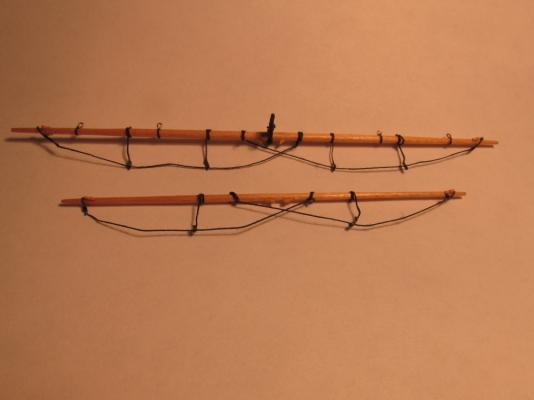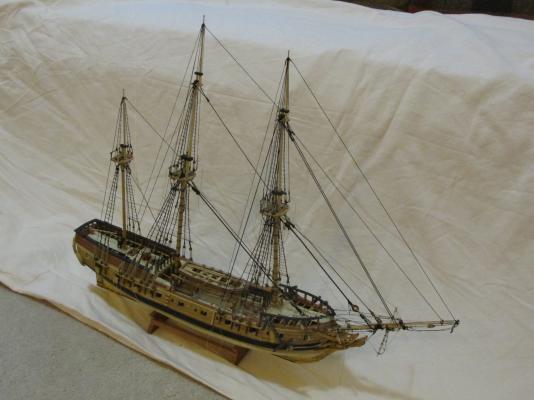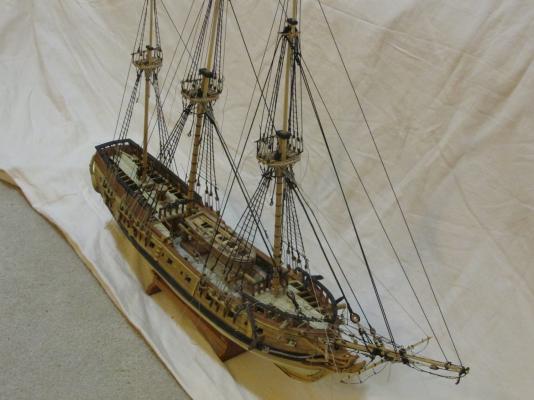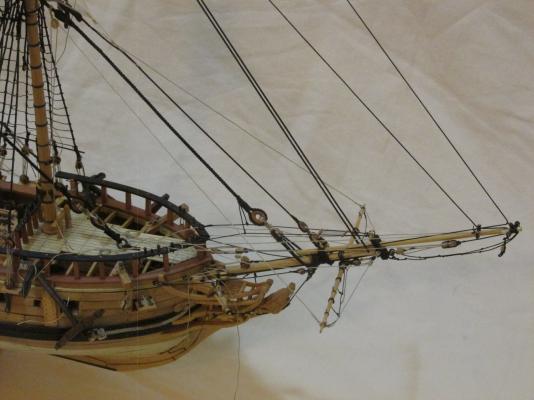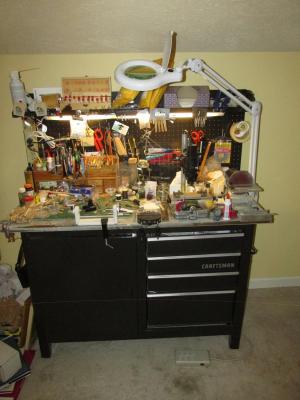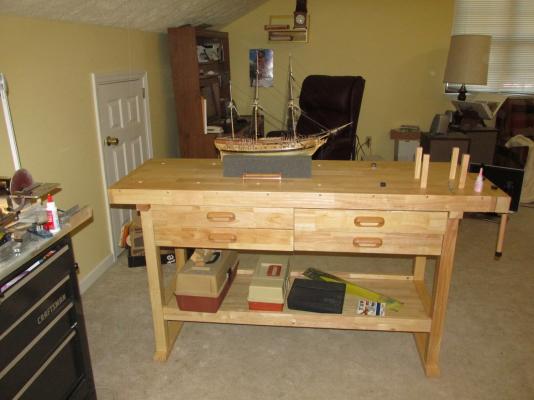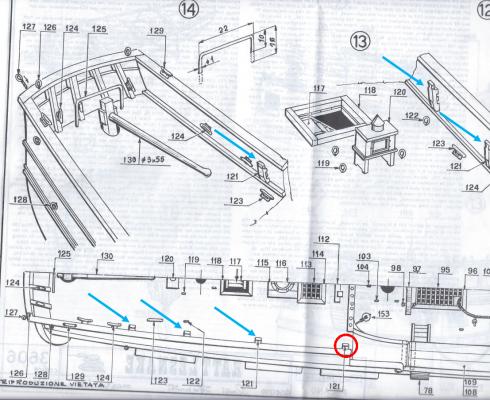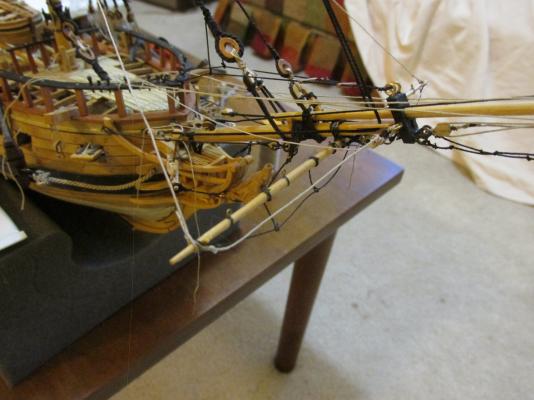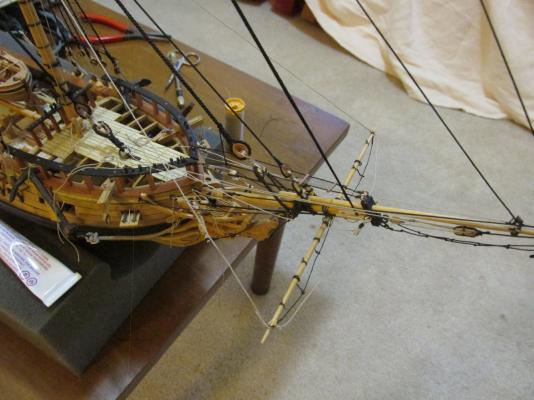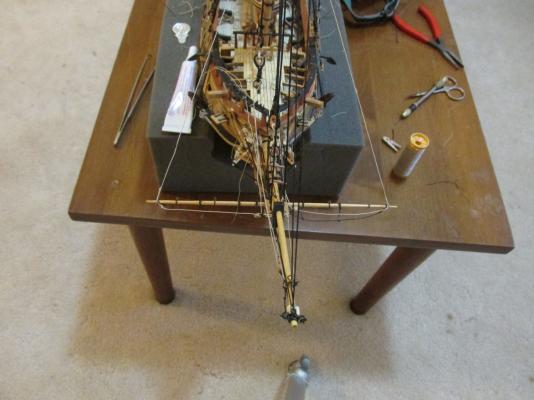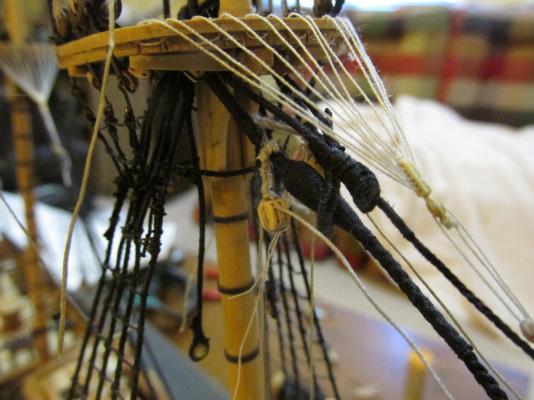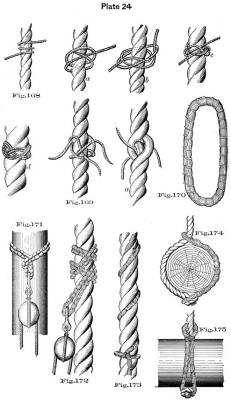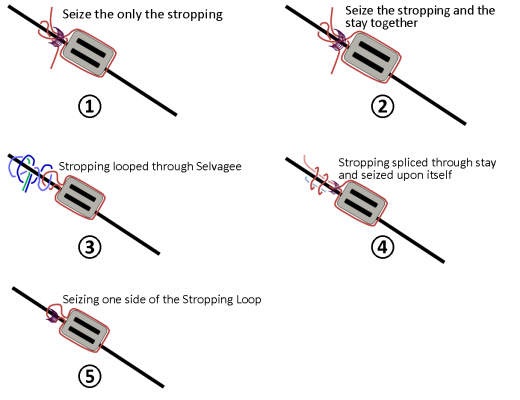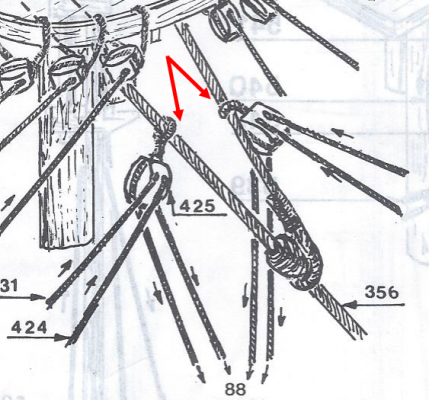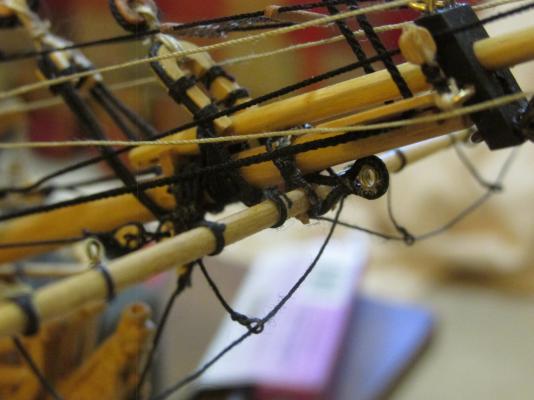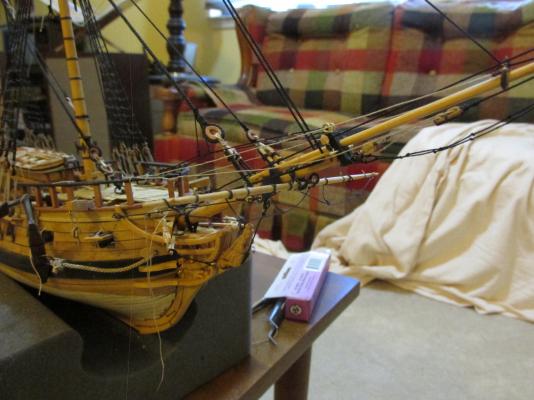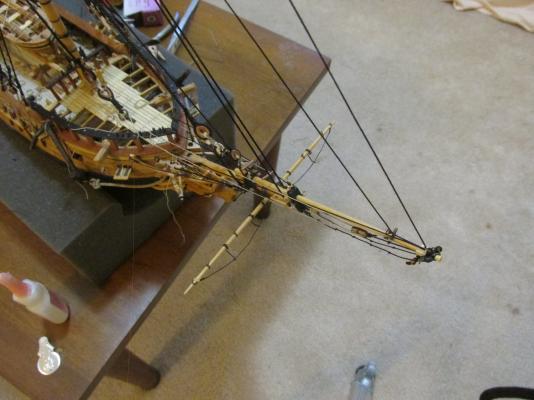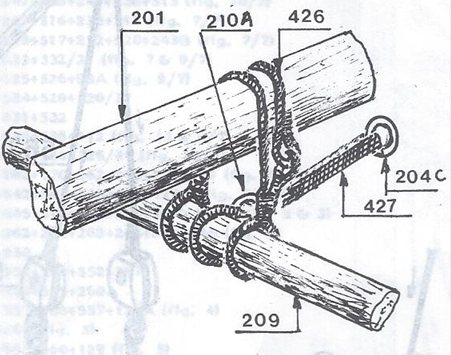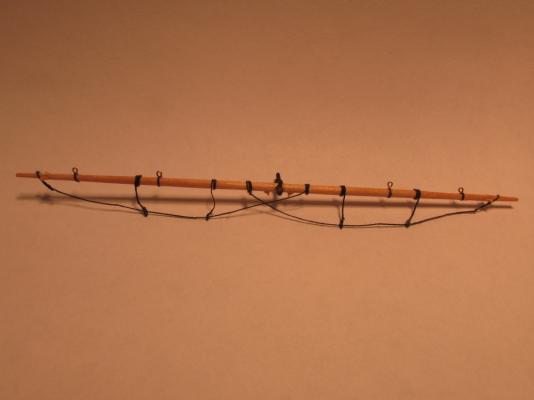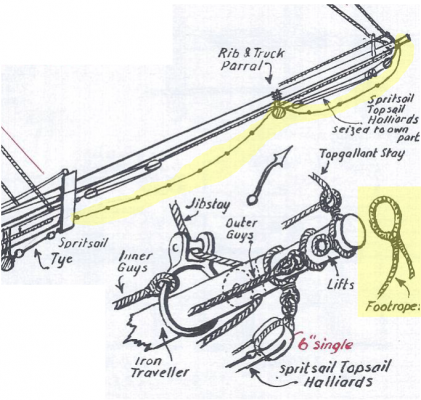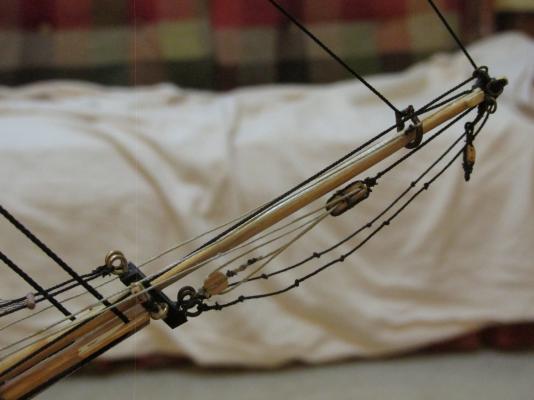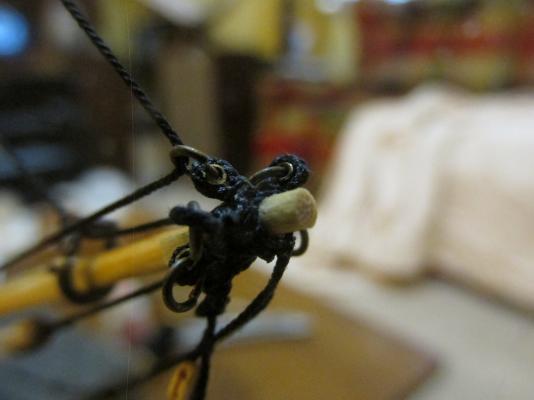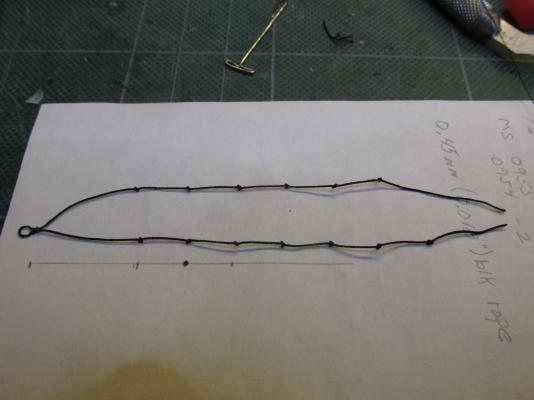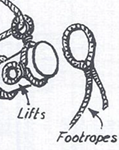-
Posts
2,481 -
Joined
-
Last visited
Content Type
Profiles
Forums
Gallery
Events
Everything posted by JSGerson
-
Therefore the first thing to make was that rigging. The sling that held the yard to the jib boom used a finer rope and was smaller and more delicate than the one on the spritsail yard. I must have made at least three slings trying to make the loops small enough and yet still functional and most importantly the proper length. First I made it too long, then too short; the difference was only millimeters. It finally got hung.
- 974 replies
-
- rattlesnake
- mamoli
-
(and 1 more)
Tagged with:
-
Spritsail Yard Stays and Spritsail Topsail Yard My traveling is done for a while, the Holidays are over, I have no excuses left to explain my lack of progress. It was time to install the spritsail topsail yard. I thought this would be a piece of cake seeing that it was almost a duplicate of the spritsail yard installation. It wasn’t. When I made those yards last year, I added the rigging for the outhaul only to the spritsail yard. The rigging for the spritsail topsail yard outhaul used a block instead of a hook.
- 974 replies
-
- rattlesnake
- mamoli
-
(and 1 more)
Tagged with:
-
I went looking for your reference and had no luck. And where can I find the full image of the painting they used as justification? The Constitution is next for construction some time in the future and I'm trying to get all my reference together now. Thanks
- 1,348 replies
-
- constitution
- model shipways
-
(and 1 more)
Tagged with:
-
Ken, the carving is a matter of personal taste and pride whether or not anyone else can see it but you and God. I get a lot of praise from my family and friends on my Rattlesnake carvings even though I know it's very rudimentary. It was after all my first ever carvings. They didn't see the fine Bob Hunt example I was following. So, put in what ever detail makes you feel good. Jonathan
- 481 replies
-
- rattlesnake
- model shipways
-
(and 1 more)
Tagged with:
-
- 974 replies
-
- rattlesnake
- mamoli
-
(and 1 more)
Tagged with:
-
Status My last log entry was posted a few days before Thanksgiving. Then I left for my annual trip to my Sister home in colonial New England where it not uncommon to see signs on homes stating they were built in the early 1700’s. It’s just outside of Hartford CT but very picturesque. Her house is only 35 years old, but that’s another story. Anyways, I spent the week there so no work was done on the model. Last week I returned home and thought I was all set to start work on the Spritsail Topsail Yard when I decided to check the rigging list provided by my Mamoli kit. And low and behold I discovered that I had forgotten to install the main and fore masts Topgallant stays which are very similar to the topmast backstays. So here it is, the beginning of a new week, the stays were constructed and installed, and now I am preparing to visit Mom in Florida (where else) for a week. She’s 97 and she’s got a bunch of “honey do’s” for me. I don’t know how much I’ll get accomplished this week on the model before I leave. There was one other item that also took a day of my time. About 10 years or so ago, I bought a metal work bench. It had a clean metal work surface, drawers, and a peg board to hang tools and stuff. I added the power and lights. It work great and it would still work great today if I didn’t have so much stuff on it now. It’s gotten so bad that I have to clear a small spot very time in order to do anything. The model has to be on the coffee table because there is no room. Fed up, I finally bought a wooden work bench from Harbor Freight (a China store) for $135 - cheap. It weighs about 100 lbs so it’s solid. The instructions to assemble it were easy to follow, all the holes lined up, and all the hardware fit and worked. I couldn’t have asked for more. The two benches were placed in an L-shaped configuration and the work lamp can swing to either bench. This should make things a bit easier, at least until I started accumulating stuff again.
- 974 replies
-
- rattlesnake
- mamoli
-
(and 1 more)
Tagged with:
-
I am building the Mamoli version of the Rattlesnake and am just beginning the running rigging, so your question peaked my immediate interest. According to the MS plans (of which I have a copy) there are only 3 Kevels per side on the Poop deck and none abreast of the main mast. That would be just about impossible with the gang plank at the waist. I looked at the Mamoli plans and at first glance, they confirmed what was shown on the MS plans…except for one sheet (No. 3) which I have reproduced below. I have marked with blue arrows the location of the kevels. The one circled in red is a forth kevel not shown on the other sheets. I believe that is the one you need. I have not installed this one on my model because until now, I didn’t know that it existed or that I even needed it. I hope this helps
- 481 replies
-
- rattlesnake
- model shipways
-
(and 1 more)
Tagged with:
-
Once the double blocks where installed, the spritsail yard braces and lifts were strung. The braces go from the tips of the yard directly to the pin rail. The lifts, go from the yard tips through a block on the side of the bowsprit cap (previously installed) up through the double block on the forestay and down to and through a sheave in the bitt just forward of the foremast where it’s tied off. At this point none of the lines have been tidied up or finalized. They are still a bit loose.
- 974 replies
-
- rattlesnake
- mamoli
-
(and 1 more)
Tagged with:
-
You will notice in figure 172 how a block is attached to a stay, in this case, with a shackle (or hook?) using a Selvagee (Figure 170). “A Selvagee is made by warping. rope-yarn, spun-yarn, or small stuff, according to the size required, and marling down.” If I substitute the shackle for a stropping loop I have what I’m looking for. The next problem is: how to model it at 1:64 scale? If I tried to do the actual rig as illustrated, the result I believe would be too complex and too bulky. The answer of course is to simulate it. To do that, I chose to use Method 4. One of the stropping bitter ends will be spliced through the stay and seized upon itself while capturing the other bitter end. That should satisfy my need for some sort of mechanical joint as well as make it look somewhat like a Selvagee was used. So much for theory; it didn’t work out that way. I forgot to take into consideration that that area of the main stay was served. Trying to penetrate that served rope with a needle in that confined area is almost impossible, and if perchance I should break the serving thread while trying to pierce the stay, the whole serving could unravel. So in the end, the block was just looped over the stay as originally illustrated in the plans very similar to method 1, which by the way was suggested by the Practicum’s author himself, Robert Hunt.
- 974 replies
-
- rattlesnake
- mamoli
-
(and 1 more)
Tagged with:
-
I did some research as well. I found the following illustration in the 1891 Text-Book of Seamanship, the Equipping And Handling of Vessels Under Sail Or Steam For The Use of The United States Naval Academy By Commodore S. B. Luce, page 50, plate 24. The book is a bit more modern than the 1781 Rattlesnake but I don’t think the basics had changed that much.
- 974 replies
-
- rattlesnake
- mamoli
-
(and 1 more)
Tagged with:
-
Rigging the Stay Blocks I received numerous suggestions as to attaching the double block to the stay. Thanks you all for your comments. In the image below, I’ve tried to illustrate as best I could the methods (as I understood them) you have suggested:
- 974 replies
-
- rattlesnake
- mamoli
-
(and 1 more)
Tagged with:
-
QUESTION I have to fasten double blocks to a stay as shown in the diagram below (red arrows). As indicated, it appears that the blocks just have a simple stropping loop at the top which goes around the stay. That would mean the blocks are held in position and have enough holding power to counteract the forces applied to it by pure friction. I don’t buy it. There has to be some mechanical method to take the load. Is this diagram correct? or… Is there a special type of knot or splice I should know about? Does anyone have an answer?
- 974 replies
-
- rattlesnake
- mamoli
-
(and 1 more)
Tagged with:
-
Don't worry about the nick...in the end you won't see it. As a matter of fact you won't see most the this partition due to lack of light and and the conjestion when the model is done. I put a lot of effort to make my partition look nice, but I can barely see it now.
- 481 replies
-
- rattlesnake
- model shipways
-
(and 1 more)
Tagged with:
-
At this stage, the yard is just hanging in the breeze with no additional lines for stability. That’s the next set once I figure out where all those lines go.
- 974 replies
-
- rattlesnake
- mamoli
-
(and 1 more)
Tagged with:
-
Also at that time, although not documented in this build log, the fabrication of the sling that suspends the Spritsail Yard from the bow sprit was initiated. Basically what was done at the time was to serve a length of 0.40mm beige rope supplied from the Mamoli kit with black thread rendering the rope black in color. (No use in using my fine Syren rope if it’s to be covered in served line.) A seized loop was formed at one end, wrapped around the center of the yard and seized again to itself. Coming back to it a year later, I realized that the loop was too bulky and large so it had to be done over. Using the technique demonstrated by Davis Antscherl at the last Nautical Research Guild Convention, I created a split loop which was smaller and a lot less bulky. Again the loop was seized to itself, wrapped over the bowsprit and under the yard and back where it was seized to itself, over the bowsprit again and through the initial loop and back. It was then seized to itself one last time. (No. 426 in the diagram below) Let me tell you that was no mean feat. Trying to thread the sling lines around the existing lines as well as the seizing thread lines without getting lost is enough to make you cross eyed!
- 974 replies
-
- rattlesnake
- mamoli
-
(and 1 more)
Tagged with:
-
Spritsail Yard Well, I’ve hit another milestone: the installation of the first yard on the model, the Spritsail Yard. If you may remember so long ago last October 2014, both the Spritsail Yard and the Spritsail Topsail Yard were completed and set aside.
- 974 replies
-
- rattlesnake
- mamoli
-
(and 1 more)
Tagged with:
-
I know exactly how you feel Greg. Take a look at the second paragraph of my very first post for my Rattlesnake: Jonathan
- 1,348 replies
-
- constitution
- model shipways
-
(and 1 more)
Tagged with:
-
It's been a while since I last check in on you. Your model looking good. I thought I should point out to be careful about your gun port doors. I would have recommended that you install those at the last convenient point your could. I had all but one of my doors knock off during routine handling of the model. I won't put them back on till I feel I won't knock them off again or if I feel putting them on later would be harder.
- 481 replies
-
- rattlesnake
- model shipways
-
(and 1 more)
Tagged with:
-
Maybe I can answer that question for you Ken, per the instructions in Bob Hunt's practicum he states: Two vital items are needed; a single edge razor blade and some very thin cutting disks. I'm not talking about those fat disks that Dremel makes for their Dremel tool. I'm talking about wafer thin disks. You can purchase these disks from a company called [Dedeco] International, Inc. Their address is Rt 97, Long Eddy, NY 12760 and their phone number is (914) 887-4840. You will need their super thin separating discs. You can buy a package of 25 (#5173) or 100 (#5183) and they also sell shanks for these thin discs. You might be able to get something like these elsewhere but this is where I got mine. He also states: You use your Dremel tool with the fine cutting disk in it to cut the profile into the razor blade. These disks are very fragile and easy to break so be careful and wear some eye protection. I can confirm, they are very fragile if you apply any pressure on the face of the cutting disc.
-
The footropes are supposed to be long enough to hang in an arc. According to Antscherl, the center of the arc is about three feet (~½”) below the jibboom. However, his footropes hang free because his model does not have a Spritsail Topsail Yard. On the Rattlesnake, it does have a Spritsail Topsail Yard which will be suspended in the middle of the jibboom. The plans show the footropes going above the yard. It appears the footropes slide (as opposed to being fastened to the jibboom) over the Spritsail Topsail Yard allowing the footrope to self-adjust as the yard moves along the boom. The footropes were installed with an initial three foot hang. How much they will finally hang down will depend how they drape over the yard once it is installed. Note the last image of the jibboom tip shows how crowded it gets. I had hoped to show the detail in there, but the black rope just sucks up the light so you can’t see too much.
- 974 replies
-
- rattlesnake
- mamoli
-
(and 1 more)
Tagged with:
-
The footropes, one on each side of the jibboom, terminate at the cap at eyebolts. Starting about 5 feet (~7/8”) from the jibboom tip, knots are placed every two feet (3/8”).
- 974 replies
-
- rattlesnake
- mamoli
-
(and 1 more)
Tagged with:
-
Jibboom footropes Like the horses described above, the jibboom footropes were made from black 0.30mm rope. There is a nice picture on the MS plans of how the footropes are constructed around the tip of the jibboom, which you may recognize from a previous posting.
- 974 replies
-
- rattlesnake
- mamoli
-
(and 1 more)
Tagged with:
About us
Modelshipworld - Advancing Ship Modeling through Research
SSL Secured
Your security is important for us so this Website is SSL-Secured
NRG Mailing Address
Nautical Research Guild
237 South Lincoln Street
Westmont IL, 60559-1917
Model Ship World ® and the MSW logo are Registered Trademarks, and belong to the Nautical Research Guild (United States Patent and Trademark Office: No. 6,929,264 & No. 6,929,274, registered Dec. 20, 2022)
Helpful Links
About the NRG
If you enjoy building ship models that are historically accurate as well as beautiful, then The Nautical Research Guild (NRG) is just right for you.
The Guild is a non-profit educational organization whose mission is to “Advance Ship Modeling Through Research”. We provide support to our members in their efforts to raise the quality of their model ships.
The Nautical Research Guild has published our world-renowned quarterly magazine, The Nautical Research Journal, since 1955. The pages of the Journal are full of articles by accomplished ship modelers who show you how they create those exquisite details on their models, and by maritime historians who show you the correct details to build. The Journal is available in both print and digital editions. Go to the NRG web site (www.thenrg.org) to download a complimentary digital copy of the Journal. The NRG also publishes plan sets, books and compilations of back issues of the Journal and the former Ships in Scale and Model Ship Builder magazines.





